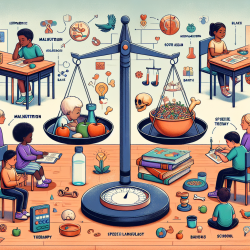Introduction
As a speech-language pathologist, your role in shaping the future of children is both profound and impactful. The journey to achieving optimal outcomes is often guided by research and evidence-based practices. The study titled "Physical and Social Availability of Alcohol for Young Enlisted Naval Personnel in and Around Home Port" offers insights that can be translated into strategies for improving child outcomes in educational settings.
Understanding the Research
The research conducted by Moore, Ames, and Cunradi (2007) provides a comprehensive analysis of the physical and social availability of alcohol among young naval personnel. It highlights the significant impact of environmental factors on behavior, a concept that can be directly applied to educational settings. By understanding how availability influences behavior, practitioners can create environments that foster positive outcomes for children.
Applying Research Insights to Educational Settings
The findings of the study underscore the importance of controlling environmental factors to influence behavior positively. Here are some strategies to consider:
- Create Structured Environments: Just as the availability of alcohol affects naval personnel, the availability of resources and structured environments can impact children's learning. Ensure that educational settings are rich in resources that promote learning and engagement.
- Implement Supportive Policies: The study suggests that policy enforcement can reduce undesirable behaviors. In educational settings, implementing policies that support positive behavior and learning can significantly enhance outcomes.
- Foster Positive Social Interactions: Social availability plays a crucial role in behavior. Encourage positive peer interactions and collaborative learning experiences to enhance social skills and academic performance.
Encouraging Further Research
While the study provides valuable insights, it also highlights the need for ongoing research. Practitioners are encouraged to explore further how environmental factors influence child development and learning. By conducting research within their own settings, practitioners can contribute to the growing body of knowledge and refine strategies to improve outcomes.
Conclusion
By leveraging research findings and applying them to educational settings, practitioners can create environments that foster positive outcomes for children. The study on alcohol availability among naval personnel serves as a reminder of the power of environmental factors in shaping behavior. As practitioners, we have the opportunity to use this knowledge to make data-driven decisions that enhance the learning and development of the children we serve.
To read the original research paper, please follow this link: Physical and social availability of alcohol for young enlisted naval personnel in and around home port.










